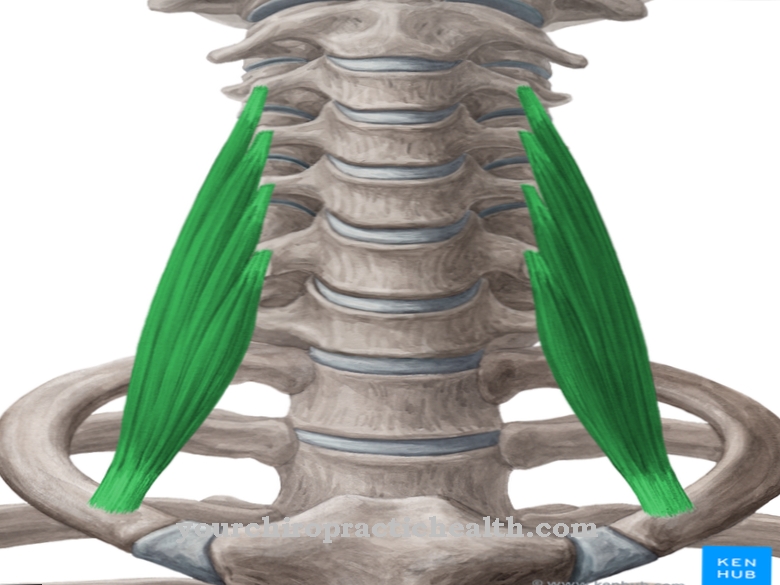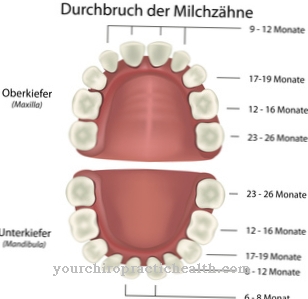The Synovia is also as Synovial fluid known and has a high viscosity. In addition to nourishing the joint, its main task is to reduce friction on the joint surfaces. In joint diseases such as osteoarthritis, the composition of the synovial fluid changes.
What is the synovia?
The medical professional uses the term synovia to describe the lubricating fluid in real joints. This synovial fluid is also found in tendon sliding devices such as bursa and tendon sheaths and is formed by the synovial membrane. This is the inner layer of the joint capsule of a joint. The synovia forms a film on the joint surfaces that ensures smooth gliding.
The term has been around since the 16th century. The doctor and alchemist Paracelsus put it together from the Greek conjunction "syn" and the noun "ovia" for protein. Literally translated Synovia means "together with protein". This designation already gives indications of the composition of the viscous liquid. Not all joints contain the same amount of synovia. The amount varies with the friction to be expected.
Anatomy & structure
The synovia of a healthy joint is viscous, yellowish, and clear. 94 percent of the liquid consists of water. The pH value of the synovial fluid is around 7.5. Synovia is obtained from the blood plasma. Their electrolyte composition was therefore very similar to that of plasma. It contains various plasma proteins as well as plasma enzymes and acid phosphatase.
Both albumins and globulins are included as plasma proteins. As a relic of the synovial membrane, the fluid also contains mucilage such as hyaluronic acid. This acid gives the synovial fluid its viscosity through pressure resistance, water binding capacity and adhesive effects.Glucose and glycosaminoglycans ensure a different viscosity depending on the load.
Function & tasks
The synovia primarily fulfills two functions. On the one hand, it nourishes the articular cartilage with glucose. On the other hand, there are fewer friction forces due to the liquid. In addition, the viscous mixture has a shock absorber effect and thus ensures that the joints are not damaged. Without synovia, the joints in the human body would show signs of wear and tear after a very short time and thus dissolve bit by bit.
The viscosity of the synovial fluid changes with the load exerted. Hyaluronic acid is responsible for this. For example, if the shear forces become stronger, the viscosity of the hyaluronic acid decreases and so creates a balance. Since the acid is actually liquid, the synovial fluid remains highly molecular in its shape. Due to this high molecular weight, the viscosity is sufficient to avoid water loss in the joint due to pressure movements. Because of chemical interactions, hyaluronic acid adheres ideally to the cartilage of a joint. Depending on the movement, the molecules in the grease bind to form spherical structures as soon as strong compressive forces act on the joint. They hang as balls on the surface of the articular cartilage.
This quality is especially important for movements like jumping. With fast movements or sudden shear movements, the viscosity of the synovial fluid is reduced. This reduction reduces the friction in the joint. The synovial fluid protects every joint from wear and tear and high loads, as it adapts to the respective movement and can change its shape within seconds. The fluid exchange and the cartilage nourishment take place through alternating relief and stress. If a joint has to be immobilized for a long time, this coordinated system of loads and reliefs is disturbed. As a result, the nutrition of the articular cartilage is also disturbed. Therefore cartilage damage occurs due to malnutrition.
Diseases
The synovia can change pathologically in its composition and quantity. Such a phenomenon occurs, for example, in diseases such as osteoarthritis, but also in other joint diseases. This is a degenerative joint disease. The organism reacts to all joint changes with an excessive production of synovia. This phenomenon is also known as joint hydrops and can be due to an inflammatory process in the joint or after signs of wear and tear in the joints.
Because of the excess of synovial fluid, the joint now looks swollen from the outside. There is either an actual effusion or swelling of the capsule. Simultaneously with overproduction, the synovia also changes its composition. The synovial fluid becomes more watery. Either the fluid becomes cloudy due to cell abrasion or it even turns dark due to bleeding. If there is bleeding, the synovia even acts aggressively on the articular cartilage. Because of the lost viscosity, the synovial fluid can no longer do its job.
If there are no color changes and the synovial fluid is still clear, there are still functional losses. As a result, the capsule of the joint can overstretch. We are then also talking about an irritant effusion, which is all too common in the context of osteoarthritis. The fluid can be drained from the affected joint through a puncture. Laboratory analysis of the drained fluid can reveal various changes in the composition of the synovia. In arthritis, inflammation can be detected via the synovial fluid. In the case of gout, laboratory analysis reveals evidence of a disorder in uric acid metabolism.



























